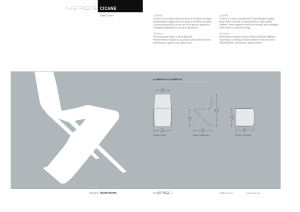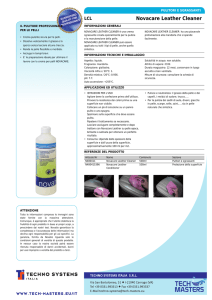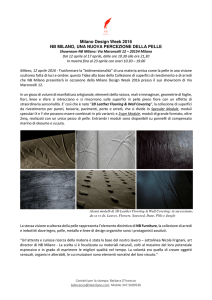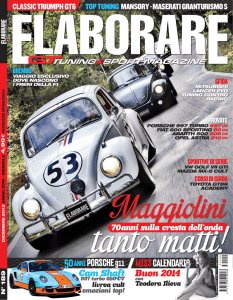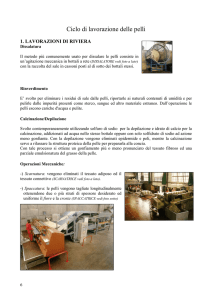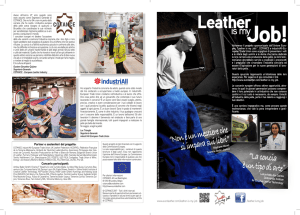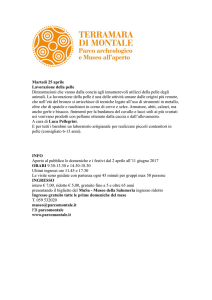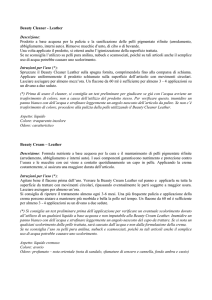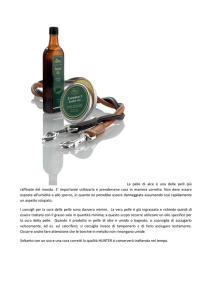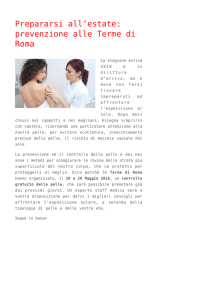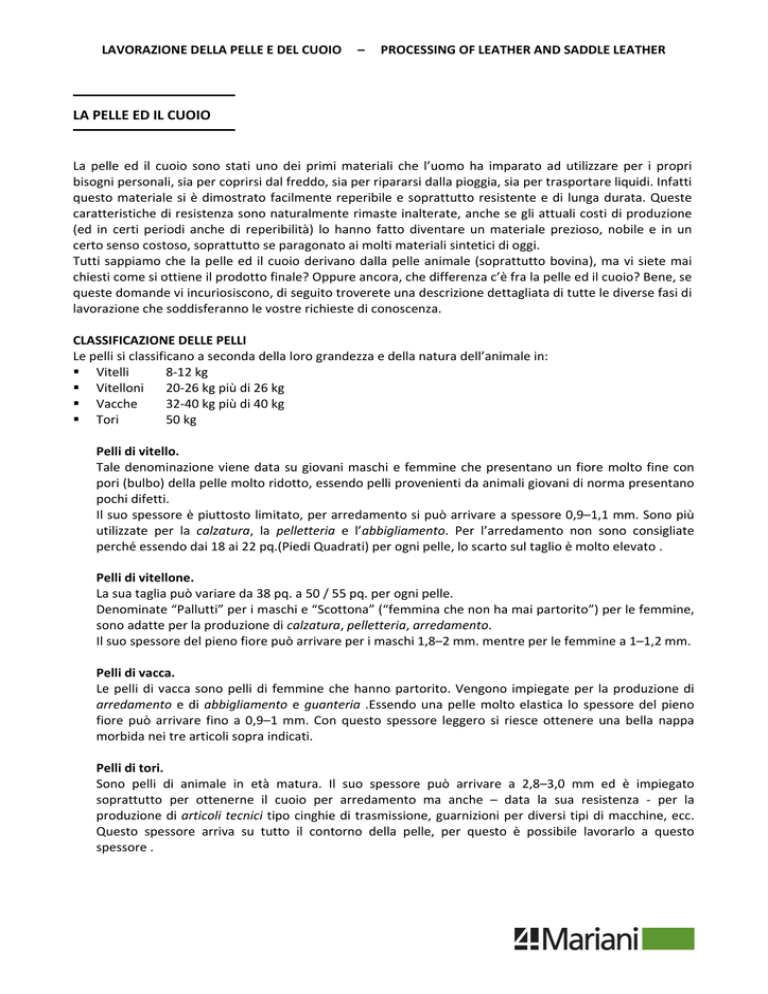
LAVORAZIONE DELLA PELLE E DEL CUOIO – PROCESSING OF LEATHER AND SADDLE LEATHER LA PELLE ED IL CUOIO La pelle ed il cuoio sono stati uno dei primi materiali che l’uomo ha imparato ad utilizzare per i propri bisogni personali, sia per coprirsi dal freddo, sia per ripararsi dalla pioggia, sia per trasportare liquidi. Infatti questo materiale si è dimostrato facilmente reperibile e soprattutto resistente e di lunga durata. Queste caratteristiche di resistenza sono naturalmente rimaste inalterate, anche se gli attuali costi di produzione (ed in certi periodi anche di reperibilità) lo hanno fatto diventare un materiale prezioso, nobile e in un certo senso costoso, soprattutto se paragonato ai molti materiali sintetici di oggi. Tutti sappiamo che la pelle ed il cuoio derivano dalla pelle animale (soprattutto bovina), ma vi siete mai chiesti come si ottiene il prodotto finale? Oppure ancora, che differenza c’è fra la pelle ed il cuoio? Bene, se queste domande vi incuriosiscono, di seguito troverete una descrizione dettagliata di tutte le diverse fasi di lavorazione che soddisferanno le vostre richieste di conoscenza. CLASSIFICAZIONE DELLE PELLI Le pelli si classificano a seconda della loro grandezza e della natura dell’animale in: Vitelli 8‐12 kg Vitelloni 20‐26 kg più di 26 kg Vacche 32‐40 kg più di 40 kg Tori 50 kg Pelli di vitello. Tale denominazione viene data su giovani maschi e femmine che presentano un fiore molto fine con pori (bulbo) della pelle molto ridotto, essendo pelli provenienti da animali giovani di norma presentano pochi difetti. Il suo spessore è piuttosto limitato, per arredamento si può arrivare a spessore 0,9–1,1 mm. Sono più utilizzate per la calzatura, la pelletteria e l’abbigliamento. Per l’arredamento non sono consigliate perché essendo dai 18 ai 22 pq.(Piedi Quadrati) per ogni pelle, lo scarto sul taglio è molto elevato . Pelli di vitellone. La sua taglia può variare da 38 pq. a 50 / 55 pq. per ogni pelle. Denominate “Pallutti” per i maschi e “Scottona” (“femmina che non ha mai partorito”) per le femmine, sono adatte per la produzione di calzatura, pelletteria, arredamento. Il suo spessore del pieno fiore può arrivare per i maschi 1,8–2 mm. mentre per le femmine a 1–1,2 mm. Pelli di vacca. Le pelli di vacca sono pelli di femmine che hanno partorito. Vengono impiegate per la produzione di arredamento e di abbigliamento e guanteria .Essendo una pelle molto elastica lo spessore del pieno fiore può arrivare fino a 0,9–1 mm. Con questo spessore leggero si riesce ottenere una bella nappa morbida nei tre articoli sopra indicati. Pelli di tori. Sono pelli di animale in età matura. Il suo spessore può arrivare a 2,8–3,0 mm ed è impiegato soprattutto per ottenerne il cuoio per arredamento ma anche – data la sua resistenza ‐ per la produzione di articoli tecnici tipo cinghie di trasmissione, guarnizioni per diversi tipi di macchine, ecc. Questo spessore arriva su tutto il contorno della pelle, per questo è possibile lavorarlo a questo spessore . LAVORAZIONE DELLA PELLE E DEL CUOIO – PROCESSING OF LEATHER AND SADDLE LEATHER FASI DI LAVORAZIONE FASE 1: Scuoiatura della pelle Con il distacco della pelle dal corpo dell’animale detta anche operazione di scuoiatura, si ottiene la pelle grezza cioè quella che ha attaccato ancora il pelo, e si suddivide in due tipologie: Scuoiatura Meccanica: la pelle viene tolta mediante aria insufflata ad alta pressione fra la pelle e la carne viva; tale operazione da’ un prodotto ottimo perché non aggiunge ulteriori difetti alla pelle stessa, non presenta cioè lo scortico tipico dell’operazione manuale. Scuoiatura Manuale: la pelle viene tolta a mano con un coltello formando qualche mancanza sul fiore o buco provocato dal taglio del coltello (questo difetto molto evidente declassa la pelle e viene chiamato “scortico”). Le pelli dopo la scuoiatura vengono salate, per preservarle dall’attacco dei batteri e mantenere una migliore conservazione. Nei periodi lunghi e con molto caldo, solitamente le pelli sono conservate nei frigoriferi. Queste due prime operazioni di scuoiatura e salatura vengono generalmente realizzate a monte cioè subito dopo il macello delle bestie; in questo modo le pelli possono essere trasportate sino alle concerie vere e proprie. FASE 2: Eliminazione del sale Una volta giunte in conceria, prima di tutto bisogna togliere il sale dalle pelli, introducendo in un bottale cilindrico circa un centinaio di pelli. Un bottale è un contenitore simile ad una botte ma molto più grande e collegato alle due estremità ad un motore elettrico in grado di farlo ruotare lungo il suo asse principale. Il bottale per questa operazione in particolare è circoscritto da una lama metallica forata, in modo che il sale tramite sbattimento fuoriesca dallo stesso. FASE 3: Rinverdimento In tale fase si restituisce alla pelle il contenuto d'acqua perso durante la conservazione e si toglie lo sporco. Le pelli vengono inserite in bottale ed immerse in un bagno d'acqua con aggiunta di sostanze tensioattive e antisettiche che agevolano il rinverdimento cioè la rivitalizzazione della pelle, la solubilizzazione delle proteine non dermiche e l’idratazione delle fibre collageniche; il tipo e la quantità di queste sostanze dipendono da come è avvenuta la conservazione. FASE 4: Calcinaio (depilazione della pelle) Le pelli, introdotte nel bottale assieme ad un'opportuna quantità di acqua, vengono depilate attraverso l'uso di sostanze riducenti (ad esempio il solfuro di sodio). L'impiego di idrossido di calcio (calce) provoca il gonfiamento del derma e la saponificazione dei grassi. Segue poi il lavaggio con acqua. FASE 5: Scarnatura Il lato carne della pelle viene ripulito dal carnaccio che è rimasto dopo la scuoiatura. Le pelli vengono introdotte una alla volta in una macchina rotativa provvista di un cilindro di gomma che preme la pelle contro un cilindro a lame elicoidali, il quale asporta il carnaccio. LAVORAZIONE DELLA PELLE E DEL CUOIO – PROCESSING OF LEATHER AND SADDLE LEATHER FASE 6: Rifilatura Dopo la scarnatura si effettua la rifilatura, operazione che consiste nell’asportare con un normale coltello, le parti inutili come sbordi, parti scorticate ecc.. Ora sulla pelle è ben visibile il fiore, difetti, piccole lesioni superficiali di varia natura. FASE 7: Spaccatura (“in trippa”) Tramite una macchina rotativa munita di una lama affilatissima, le pelli vengono divise in due parti lungo tutta la loro sezione; lo spessore puo’ essere scelto e controllato dalla macchina stessa. In questo modo si separa il “fiore” (la pelle dal lato del pelo) dalla “crosta” (la pelle dal lato della carne). In questo caso si dice che la pelle è spaccata “in trippa”. La pelle dal lato fiore ha una maggiore resistenza mentre la crosta risulta più facilmente soggetta al consumo ed è di qualità notevolmente inferiore a quella del lato fiore. FASE 8: Concia La concia consiste nel trattare la pelle con sostanze (appunto concianti), in grado di penetrare e fissarsi alle fibre stabilizzandole ed impedendone la putrefazione; viene effettuata introducendo le pelli in appositi bottali in legno. La concia vera e propria viene però preceduta da una serie di trattamenti: è infatti necessario eliminare i residui di calce della operazione precedente (trattamento di decalcinazione) e diminuire il pH fino a circa la neutralità (trattamento di piclaggio tramite acido lattico e acido solforico). Successivamente si fa uso di enzimi maceranti per migliorare l'apertura e il rilassamento dell’intreccio fibroso del derma, per renderlo cioè più reattivo nei confronti della fissazione del conciante (trattamento di macerazione) e quindi si procede con la concia vera e propria. Esistono diversi tipi di concia a seconda del materiale conciante utilizzato (al cromo, al vegetale, all’aldeide, all’olio etc.), ma quella più diffusa è senz’altro quella al cromo. Nella concia al cromo vengono utilizzati Sali di cromo e bicarbonato di sodio. Essa consente di ottenere cuoi dotati di particolari proprietà, che si prestano alla produzione di un’infinità di articoli, molti dei quali sono impossibili da ottenere con altri tipi di concia, come quella con tannini vegetali. I Sali di cromo formano con le fibre della pelle, un legame più stabile rispetto le altre sostanzi concianti, infatti si ottengono dei cuoi con resistenza idrotermica di circa 100°C. La concia al vegetale viene effettuata con tannini vegetali (come la mimosa, castagno, ecc..) Tale concia è utilizzata ad esempio per la produzione di cuoio da suola. La resistenza idrotermica finale è sull’ordine dei 70‐80 °C. Le pelli ottenute da conce miste invece hanno caratteristiche diverse a seconda dei concianti utilizzati, tali conce però non sono molte utilizzate. Concludendo si può dire che la concia al cromo è il migliore compromesso tra le caratteristiche tecniche che si ottengono e il campo di applicazione in cui si possono utilizzare le pelli conciate con questo tipo di conciante. Le pelli conciate al cromo vengono denominate Wet Blue perché al termine dell’operazione assumono un tipico colore azzurrino/bluastro. FASE 9: Pressatura Le pelli vengono introdotte una alla volta in una macchina rotativa che, schiacciando le pelli tra due cilindri, elimina circa l’80% dell'acqua che contengono. LAVORAZIONE DELLA PELLE E DEL CUOIO – PROCESSING OF LEATHER AND SADDLE LEATHER FASE 10: Spaccatura Se questa fase non è stata fatta prima della concia (cioè “in trippa”) allora la si effettua ora con le pelli in Wet blue. Questa seconda opzione è sempre più diffusa per abbattere i costi di trasformazione ( infatti si ha una sola concia sia per il fiore e che per la crosta che sono ancora una unica pelle) anche se la qualità ottenuta è sicuramente inferiore alla pelle spaccata in trippa. FASE 11: Rasatura La pelle viene portata lungo tutta la sua estensione allo spessore voluto asportando materiale dal lato carne con una macchina con concezione simile alla scarnatrice. FASE 12: Riconcia, tintura ed ingrasso A questo punto le pelli vengono introdotte nei bottali per subire tre tipologie di lavorazioni: La riconcia: è preceduta dal trattamento di neutralizzazione tramite bicarbonato e calcio formiato per portare il PH a dei valori ottimali per questa fase. La riconcia consiste nel riempimento dei meati della pelle conciata tramite l’incorporazione di tannini vegetali, sintetici o resine per conferire maggiore pienezza e compattezza all’articolo finale; essa può essere al cromo (stesso trattamento precedente) o essere al vegetale, ed in tal caso viene chiamata riconcia vegetale o mista cromo. Tintura: serve per conferire il colore alla pelle ed è realizzata tramite sostanze come colorante, bicarbonato, sali di acidi e acido formico (che serve per fissare il colore). Esistono due tipologie di tinta: superficiale o passante. Nella prima la pelle è tinta solo sulla superficie per cui un graffio mette alla luce un colore diverso, nella seconda invece la pelle è tinta lungo tutto il suo spessore. N.B. L’anilina è una sostanza chimica che puo’ intervenire nelle operazioni di tinta sia in bottale che in semplice fase di rifinitura superficiale. Il pentaclorofenolo era utilizzato in passato come antibatterico ma per la sua tossicità è stato vietato. Ingrasso: consiste nella lubrificazione delle fibre dermiche onde evitare l’incollaggio e il riempimento dei meati interfibrosi, in altre parole per conferire morbidezza e pienezza alla pelle. Infatti se così non fosse, nella successiva fase di asciugatura la pelle diventerebbe dura e fragile; con l’ingrasso introduciamo un lubrificante che prenderà il posto dell’acqua che poi evaporerà. E’ realizzato tramite ingrassanti, olii e acido formico. FASE 13: Asciugatura Si hanno due tipologie di asciugatura: Asciugatura al sottovuoto. L’asciugatura al sottovuoto si effettua generalmente per pelli destinate al settore calzatura e per il cuoio; sono eseguite queste fasi: Messa a vento. Viene effettuata tramite una macchina detta retorsa la quale distende la pelle e toglie la ruga sulla testa delle pelli,eliminando l’80% di acqua . Sottovuoto. Si esegue inserendo la pelle fra due piastre riscaldate a vapore a 40°‐60°; una volta inserita la pelle con il fiore rivolto verso il basso, si fa scendere la piastra superiore la quale tramite aspirazione crea del vuoto fra le due piastre. A seconda dello spessore questo processo dura da 4 a 10 minuti e grazie a questo vuoto e al calore la pelle si asciuga e si compatta acquisendo un fiore più gentile e fermo. Catena. Si mettono le pelli una ad una su dei paletti in modo che fuoriesca il vapore e la pelle finisce la sua asciugatura al naturale . Palissonatura LAVORAZIONE DELLA PELLE E DEL CUOIO – PROCESSING OF LEATHER AND SADDLE LEATHER Questa fase si effettua tramite un’apposita macchina detta palissone, la quale serve per ammorbidire la pelle e portarla omogenea per poter rifinirla. Asciugatura a telaio bagnato. E’ tipico del settore arredamento, nappe ed abbigliamento. La pelle viene messa su una rete metallica agganciata a delle pinze, viene tirata come un tamburo ed entra in un tunnel dove si trova aria calda forzata a circa 60 °C che nel tempo di 5‐8 ore asciuga la pelle. FASE 14: Rifilo Vengono tolte le parti che non servono e che ostacolano sul lavoro che prosegue. FASE 15: Palissonatura La palissonatura è un’operazione meccanica eseguita a seguito dell’essicazione che serve per distendere le fibre della pelle che durante la seccatura si sono come “incollate”. Per questo le pelli vengono fatte passare per il palissone che è una macchina composta da cilindri che vibrano. La pelle passando tra questi cilindri la comprime, distendendola e ammorbidendola. N.B.: La pelle va palissonata anche quando è finita per ottenere una qualità migliore. FASE 16: Prebottale Serve per ottenere una pelle migliore e morbida. FASE 17: Telaio per asciutto La pelle viene distesa nel telaio per asciutto in modo che nella successiva fase di rifinitura ci sia una migliore penetrazione dei prodotti additivi all’interno della pelle; così facendo si evitano screpolature a pelle finita. FASE 18: Rifinitura ‐ Stiratura Per migliorare le caratteristiche della pelle vengono applicati strati successivi di prodotti più o meno coprenti con vari scopi, in relazione all'articolo. Questa applicazione viene effettuata utilizzando pistole a spruzzo montate su di una giostra girevole, mentre le pelli vengono stese su un nastro trasportatore. L'applicazione successiva di due strati di prodotti può avvenire sulla stessa linea (stesso nastro trasportatore) con due impianti di spruzzo diversi (due "cabine"). In alcuni casi al posto degli spruzzi si possono utilizzare macchine rotative in cui un cilindro è ricoperto dalla sostanza da depositare (macchine spalmatrici a rullo). A circa metà del processo di rifinitura, la pelle viene stirata in modo tale che le resine che sono state depositate sulla stessa si possano distendere meglio e in modo più uniforme. In seguito il processo di rifinitura riprende sino alla sua conclusione; la pelle viene poi nuovamente stirata. FASE 19: Conclusione Dopo la stiratura la pelle viene lasciata riposare per almeno 12 ore, messa a girare in bottale per altre 12 ore per conferire ulteriore morbidezza, palissonata, scelta, stirata leggermente, misurata e infine imballata. APPLICAZIONI SUL “NOSTRO” CUOIO E SULLE “NOSTRE” PELLI L’Azienda da sempre utilizza le proprie pelli ed il proprio cuoio; cioè non acquista il prodotto finito da rivenditori o commercianti ma bensì va direttamente alla fonte acquistando le pelli grezze direttamente dalla conceria. Dopo l’acquisto le pelli subiscono le diverse fasi di lavorazione presso le migliori aziende conciarie che l’Azienda ha selezionato negli anni – ognuna per ogni singolo processo/prodotto ‐ tutte situate nei dintorni di Arzignano (VI), la più importante Area italiana dell’industria conciaria. LAVORAZIONE DELLA PELLE E DEL CUOIO – PROCESSING OF LEATHER AND SADDLE LEATHER Seguendo direttamente tutte queste lavorazioni possiamo controllare passo dopo passo la qualità delle nostre pelli oltre ad avere la totale esclusività della gamma cromatica della collezione; al termine del processo riusciamo ad ottenere un prodotto realmente di altissima qualità per le categorie superiori e di ottima qualità anche per quella medio‐inferiore. Innanzitutto è importante precisare che le pelli grezze impiegate dall’Azienda sono di provenienza esclusivamente Europea ed in particolare da Germania, Francia, Svizzera, Austria ed Italia. Questa provenienza è di per sé già una garanzia in quanto gli animali di questi Paesi sono soliti trascorrere la loro vita in pascoli mediamente ben controllati e quindi sottoposti ad un basso rischio di danneggiamento della loro pelle. Durante l’acquisto delle pelli grezze viene valutata la qualità delle stesse, cioè viene effettuata la cosiddetta scelta delle pelli. Premettendo che è molto difficile che ci siano pelli senza alcun difetto, la scelta non è altro che una selezione delle pelli, in base al numero ed entità dei difetti che si possono presentare (scortico, cicatrici, sterco, pori, punture di insetti, malattie etc..). Il numero di scelte varia dal tipo di pelle in questione e dal paese in cui ci si trova; generalmente comunque ci sono due tipologie e 5 livelli di scelta. Il primo tipo di scelta – detto scelta in Wet blue ‐ va effettuato valutando le pelli dopo la fase di concia (appunto Wet blue); questa scelta è sicuramente quella più importante, ma anche quella più difficile, in quanto molti difetti non sono visibili, se non solamente in fase di lavorazione. La scelta fatta in finale – cioè dopo le fasi di trattamento superficiale ‐ invece serve per selezionare le pelli in base ai difetti che sono sorti in fase di lavorazione, e che magari erano poco visibili o non accentuati in fase di scelta in Wet blue. Ad esempio per la nostra categoria PF, le pelli sono di 1° scelta, per il cuoio invece, viene effettuata una scelta su mezze pelli, ancora migliore, denominata prima super, in quanto i difetti sono quasi inesistenti. Naturalmente anche le pelli con molti difetti – anche abbastanza gravi ‐ possono per così dire essere “riparate”. Se i difetti sono superficiali (come ad esempio i graffi) si procede alla smerigliatura, un’operazione con la quale si asporta per abrasione una parte superficiale del fiore ed in seguito ad una finitura che stampi un finto fiore; se invece la pelle presenta buchi o notevoli difetti, l’unica soluzione è quella di stuccare con appositi prodotti i buchi, e successivamente smerigliare e stampare il finto fiore. Sulle pelli categoria PF e PS e sul cuoio viene eseguito un trattamento di finitura superficiale di idrorepellenza che consiste nell’impiego di particolari additivi che creano un film superficiale in grado di resistere per un certo tempo all’acqua. Come si puo’ constatare dalla tabella precedente, per tutte le diverse categorie noi utilizziamo vera pelle dal lato fiore e quindi non impieghiamo croste. Anzi praticamente oltre il 95% del nostro consumo è costituito dalle categorie CF, PA, PX e PF cioè le nostre tre migliori categorie pieno fiore senza alcun ritocco o smerigliatura: insomma TOTALMENTE NATURALI. LEATHER AND SADDLE LEATHER Leather and saddle leather were one of the first materials that man learned to use for their own personal needs, either for protection from the cold and rain, or to transport liquids. In fact, this material was easily available and above all resistant to natural perils of the time and was durable. These characteristics endured even though the actual costs of production and also of availability LAVORAZIONE DELLA PELLE E DEL CUOIO – PROCESSING OF LEATHER AND SADDLE LEATHER now make leather a more expensive material in current times. It is a noble and precious material compared to the synthetic items now available. We all know that leather and saddle leather are derived from the skins or hides of animals, usually cows, but have you ever wondered how the final products arrives or what the differences are between regular leather and saddle leather ? If these questions make you curious, then the following detailed descriptions of the leather working process will satisfy your quest for knowledge. CLASSIFICATION OF THE HIDES. The leather is classified according to their size and by the origin of the animal: Calves 8‐12 Kg. Bullock 20/26 Kg more than 40 Kg. Cow 32/40 Kg. more than 40 Kg. Bull 50 Kg. Calves Hide This denomination is given to young male and female calves that present a grain very thin with pores of the skin greatly reduced, as the leather comes from young animals usually they present few defects. Its thickness is almost limited, for use in furniture, because you can arrive at only a maximum thickness of 0.9 – 1,1 mm. They are more used for shoes, leather trade and clothing. For the furniture sector they are not recommended because, being hides from 18 to 22 square feet, the reject rates is very high. Bullock hide Its size can vary from 38 square feet to 50‐55 square feet per hide. In Italy we call them “Pallutti” for the male and “Scottona“ for the female that never has never given birth, they are suitable for the manufacturing of shoes, leather trade and furniture. Its thickness of the full grain leather can be for the male, 1,8–2 mm. for the female, thickness can be 1‐
1,2 mm. Cow leather The cow hides are hides of female that have given birth. They are used for the production of furniture, clothing and gloves. As the hide is very elastic, the thickness of the full grain can vary up to 0,9‐1 mm. With this light thickness, you manage to obtain a nice soft leather in the three items mentioned above. Bulls They are hides of animals ripe in age. Its thickness can be up to 2,8‐3,0 mm. and from them we can obtain saddle leather for the furniture field but also for the production of technical items like drive belts, trimming for different kinds of machines, and so on. This thickness arrives throughout the hide, so it is possible to work it at this thickness. STEPS OF THE MANUFACTURING PROCESS STEP 1: Skinning of the hide The hides start with hair, and there are two kinds of skinning: ‐ Mechanical skinning: (excellent), where the hide is taken away through air pressure (between hide and flesh) and defects are not added to the skin. ‐ Manual skinning, where the hide is taken off by hand with a knife, thereby creating some lack on the pattern produced by the cutting of the knife, (this defect very evident degrades the skin and is called skinning). LAVORAZIONE DELLA PELLE E DEL CUOIO – PROCESSING OF LEATHER AND SADDLE LEATHER The hides are corned after the skinning to avoid the attack of batteriums and for a long lasting preservation. During long and very hot periods, it is recommended to keep the hides in refrigeration for storage. The skinning and the salting are usually made immediately after the slaughtering of the animals, in order to transport the hides till the tanneries. STEP 2: Desalination Once the hides arrives to the tannery, first of all it is necessary to take off the salt introducing in a cylindrical drum containing about one hundred hides. The drum is similar to a barrel but much bigger; at one extremity there is an electric engine that makes it rotate on its own principal axis. The drum used for this particular job is circumscribed by a perforated metallic blade, so that the salt comes off the drum during the shaking. STEP 3: Revitalizing In this operation in the hide there is a return of the water content that was lost during the conservation and there is also a cleaning action. Into the drum, the hides are dipped in a water‐bath with the addition of surface‐active agents and antiseptic substances that facilitate the increase in moisture content and in the solubilization of the non dermic proteins. The typology and the quantity of all this chemical substances used in this step depend on how was made the preservation of the hide. STEP 4: Lime‐Pit (hair removal of the hide) Once introduced into the barrel together with an appropriate quantity of water, the hides are removed from the hair through the use of reducing substances ( for example the sodium sulphide). The employment of hydroxide of calcium causes the swelling of the derma and the saponification of the fats. Washing with water follows. STEP 5: Fleshing The meat side of the hide is cleaned again by removing the coarse meat that is left after the skinning. The hides are introduced one at a time into a rotary machine containing a rubber cylinder that press the hide against a cylinder with helicoidal blades, that remove the coarse meat. STEP 6: Trimming After the fleshing, we execute the trimming operation consisting of removing, with a normal knife, the useless sides, such as edges, skinning parts and so on. Now, the pattern defects and small superficial wounds of different natures are evident in the hides. STEP 7: Splitting Through a rotary machine operating with a sharp blade, the hides are divided into two sides all along the section; the thickness of the two different sides can be chosen and controlled by the machine. During this step there is the separation of the grain (hair side) from the split (meat side). The leather of the grain side is absolutely better than the split one because of his quality and strength. STEP 8: Tanning This process is the most important because it makes the leather imputrescible through the use of particular substances that can LAVORAZIONE DELLA PELLE E DEL CUOIO – PROCESSING OF LEATHER AND SADDLE LEATHER penetrate and be fixed into the hides. The process is run in big wooden drums but the real tanning is preceded by a series of treatments. It is infact necessary to eliminate the rest of the lime (STEP 4) and to reduce the Ph to neutral. Subsequently we use macerating enzymes to better open the fibres and make the hide more reactive to the tanning substances. There are different tanning processes depending on the substances used ( for example chrome‐tanning, vegetable‐tanning, aldheyde‐tanning, oil‐tanning etc.); the more common process is the chrome one. In the chrome tanning are used chrome salts and sodium bicarbonate. With this kind of tanning are made leathers that can be used for many different purposes that can not be reached with other methods; infact the chrome salts create with the hide fibers a binding more solid than with other substances. This kind of leathers have an hydrotermic resistance of 100° C. In the vegetable tanning are use vegetable tannins ( like the mimosa or chestnut ones) for the production of leather soles; infact the hydrotermic resistance is around 70‐80° C. There are also mixed tanning like the chrome‐vegetable tanning, used for very particular needs. At the end of the chrome tanning the hides are called Wet‐Blue because of their light blue colour obtained during the process. STEP 9: Pressing In this processing the hides are introduced one at a time into a rotary machine that crushes the hides between two cylinders, eliminating the 80% of the water that they contain. STEP 10: Splitting If it has not been made during the processing STEP 7, the splitting is done now that the hides are in wet blue stage. For economic reasons the companies now are more used to make the splitting after the tanning and not before even if the quality of the final materials is lower. Infact in this way there is only one tanning process (instead of two) both for the grain and for the split. STEP 11: Thinning During this process the thickness of the hide is made equal and of the desired dimension thickness along all the hide, by removing material from the meat side with a machine similar to that used during the unfleshing STEP 5 process. STEP 12: Re‐tanning, tincture and fattening The hides are introduced into drums for 3 different process: Re‐tanning is preceded by the neutralization of the PH to the right figure for this process. The re‐tanning is made exactly as the tanning and in general is chrome‐tanning or vegetable‐tanning. This operation is made especially to enhance the properties of the hide (absorption of the products during finishing, for fullness and softness). Dyeing: it is used to give the desired colour to the hide through sodium bicarbonate, acid salts and colour pigment. There are two kind of dyeing: superficial dyeing where the colour is fixed only to the surface of the leather (so that a scratch shows a different colour) and the through dyeing all through the thickness of the hide. The aniline is a chemical substance that can be used during the dyeing in drum or also in the final step of superficial Dyeing (see step 18). Pentaclorophenol was used in the past as antibacterial substance but now is forbidden for his toxicity. Fattening: it is used to bring the leather to a right softness through oils, fattening and formic acid. It is very important process because in the hides fibers these substances will take the place of the water during next process of drying and maintaining in this way the right softness. LAVORAZIONE DELLA PELLE E DEL CUOIO – PROCESSING OF LEATHER AND SADDLE LEATHER STEP 13: Drying After the dyeing, the hides are dried in two possible ways: Drying at vacuum–pack For the drying at vacuum‐pack, we execute these phases: Winding ( through twisting machine). It is made through a machine that extends the hide and takes out the wrinkles on the hides, eliminating 80% of the water. Vacuum‐pack. In this process the hide is placed between two plates heated at 40°‐60°, and then we dry the leather from 4 to 10 minutes, according to the thickness. In this way, we obtain a solid leather with a grain more delicate and stable. Chain. We secure the hides one by one with stakes in order that the vapour comes off and the hide finishes with its natural drying. Staking. This phase is effected staking skins and it is made to soften the hide and to give it a uniform state. Drying at wet frame Is used especially for furnishings, nappa and clothing leathers. The hide is put onto a metallic net and hooked to some pincers. Then, it is pulled tight like a drum and it goes into a tunnel, where there is warm air forced onto it at about 60° C, which during the time of 5‐ 8 hours, dries the hide. STEP 14: Trimming We take off the sides that we don’t need and that obstructs the work that follows. STEP 15: Staking It is a mechanical process used to soften the leather in an homogenous way; infact after the drying the hide fibers are like pasted together and so they are run into a machine made by steel cylinders that press, spread and stretch out the leather. The hide must be staked also when it is finished in order to obtain a better quality. STEP 16: Pre‐drum It is used to obtain a better and soft leather. STEP 17: Frame for drying After the drum and before finishing off, the leather is extended on the chassis for drying so that the finishing touch and substances enters into all sides of the leather, in order to prevent any creases in the finished leather. STEP 18: Finishing ‐ Stretching In order to better finish the leather, successive layers of substances are applied more or less covering for the different purposes, with regard to the needs of the article. This process is made using spray guns mounted on a swivel merry‐go round, while the hides are laid down on a conveyor belt. The application of two layers of products can happen on the same conveyor belt with two different applications of sprays. In some cases instead of the sprays you can use rotating machines in which a cylinder is covered with the substance to put down using a spreading roll machine. For the finishing touch, the leather is stretched in order to extend the resins in the best way on all the leather dimension. STEP 19: Conclusion LAVORAZIONE DELLA PELLE E DEL CUOIO – PROCESSING OF LEATHER AND SADDLE LEATHER For final finishing, there is the application of the final colour, then it is stretched again for 12 hours, run into a drum for at least 12 hours, staked, selected, lightly stretched, measured, and packed. APPLICATION ON OUR LEATHER AND SADDLE LEATHER The Company always uses our own leather and also our own thicker saddle leather. We do not buy the finished product from suppliers or retailers, but go directly to the source and buy the raw hides directly from the tannery. After the initial purchase, the leather begins the different phases of processing by the best companies that the Company has selected over the years, with each one specializing in a single process of procedure. All are situated around Arzignano town, in the Vicenza area, which is the most important Italian area for the tannery industry. We directly follow all of the working processes and we can check step by step the quality of our hides to maintain the complete exclusivity of the brilliant range of the collection. At the end of the process, we can obtain a product of real high quality for the superior product categories, and also good results for the lower and middle quality range applications. Above all, it is important to state that the raw leather hides utilized by the Company come exclusively from Europe and particularly from Germany, France, Switzerland, Austria and Italy. These places of origin are already a guarantee because the animals of these countries are used to spending their lives in pastures that are well controlled, and therefore to low risk of damage to their hides. The quality of the hides is evaluated for various specifications and determines which are to be purchased. It is very difficult to obtain hides with no defects, and so the numbers and types of blemishes are considered. This may include scars, the size of the skin pores, insect bites, the effects of illness and so on. Two different thickness of leather are available and are known as either regular of the thicker saddle leather. Only one grade of saddle leather is available. For the thinner regular leather, three different grades are possible. The grades are determined during the tanning process. The first phase of evaluating and grading the leather is made after the initial tanning process and is known as WET BLUE. The first inspection is surely the most important, but is also the most difficult because it is not possible to see many defects during the initial leather working process. Additional inspections are made after subsequent leather tanning phases than were first visible during the initial WET BLUE process. For example, the category PF leathers are of premium quality and the defects are almost non existent. The saddle leather is made from thicker half hides, but shares the same premium quality. Leather arrives naturally with many defects and even the worst can be repaired. Superficial scratches are polished away and the smooth area is printed with an imitation grain which matches the rest of the hide. Holes or big defects are filled with special products, followed by polishing and imprinting of the grain. Hides requiring repair are graded only on Commercial quality. All leather products are treated with a final additive that enables them to repel water for a period of time. All leather categories utilize real leather from the grain side. We do not use the inferior crust side of the leather. Basically almost 95% of our products use the CF, PA, PX and PF leather qualities which are the very without any retouching or polishing away of defects. They are completely natural.

